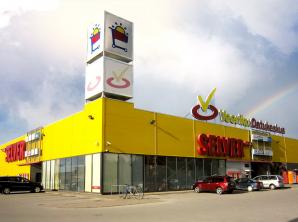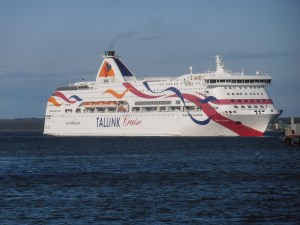Aldos’s — Greenport, Long Island, New York, USA
Aldo’s is a coffeehouse on the water in Greenport, Long Island, New York, which is where we lived last year. In Aldo’s, I ordered a lot of cappuccinos from the friendly Guatemalan ladies who worked there, and wrote. I found it easy to write about Tartu from far away, because it allowed me to create my own Tartu, rather than to be distracted every time somebody walked by. In Aldo’s, I wrote the first chapters for the new book, including Väino’s Magic Trick, Woodsman Mats, and Keeping the Fires Lit. Aldo, the proprietor, who was this tough little Sicilian guy with a bush of white hair, would often be roasting coffee beans in the same room. If you stood outside, you could see the smoke coming out of the chimney and could barely breathe because it filled the air with a strong aroma. It probably inspired to write so much about wood-heated furnaces.
Costa Adeje — Tenerife, Canary Islands, Spain
I was already deep in the book when we went to Tenerife at the end of February this year. While Epp watched our girls on the beach, I wrote in the little restaurants that line the water in Costa Adeje and Playa de las Americas. To keep myself going, I would order inexpensive appetizers, like pimientos de padron, Spanish green peppers, and papas arrugadas, a Canarian speciality, where baby potatoes are boiled with sea salt, producing a certain, wrinkled texture. I remember how I was trying to describe how Rein Taagepera, a political scientist who figures prominently in one chapter, looked, and then glancing down at the bowl of boiled potatoes.
“When Taagepera’s eye slits opened a bit, you could see the irises, which were an otherworldly intelligent blue. All of the skin on his face seemed to fold into itself, like the wrinkled and puckered peel of a yellow baby potato boiled away in sea salt.”
Veeriku Selver — Tartu, Estonia
When I was working on the book, I usually kept a journal in my coat pocket, just in case some ideas would start to flow in while I was sitting somewhere. Writing is not really about the act of applying pressure to a keyboard, I guess. It’s more about listening to the various streams of language and memories flowing through your head. So I found myself in Veeriku Selver last autumn, waiting while the mechanics at the garage around to corner put the winter tires on our car, and jotting down thoughts for the book. A woman saw me writing and asked if she could take my picture. “It’s my hobby — I like to photograph people. And you still use a journal, wow, such old-fashioned technology.” I let her take my photo, and when she was done, she stroked my head a few times and left. She smelled like vodka, but all together it was a nice encounter.
Päris Pariis — Tartu, Estonia
It was in Päris Pariis where I finally realized that I was going to have to write the damn book through to the very end. This is a newer cafe on Lai Street in Tartu run by a Frenchman named Matthieu Chillaud who speaks Estonian to his clients with his outrageous accent (and yes, we speak Estonian to each other sometimes too). There are round tables built out of barrels, and a fine selection of galettes and crepes. As you work, you can listen to old French pop songs. It was here that I wrote a lot of good dialogue, I remember, including the back and forth with Vello Vikerkaar from the First True Writer chapter. Sometimes when I write good dialogue I enjoy it so much that I laugh out loud, so I’m sure some other patrons of Päris Pariis thought I was crazy.
Cafe Fellin — Viljandi, Estonia
I know some writers hate to be disrupted while they are writing, and they need a very, very quiet place to reflect, but I love working in a place like Fellin, where friends stop by and say hello. First Tiina Kaalep came by, and I tried to explain to her how Estonians had a different way of seeing the world, their own Order of Things, and I told her about my neighbor Peep in Viljandi who liked to saw wood at midnight. “Normaalne,” she said. At last, just when I was settling into working again, after meeting another good old friend, I saw our old neighbor Gea heading toward the door with her young son Samuel and I waved to her. This became part of the last scene in the book.
M/S Baltic Queen — Somewhere between Estonia and Sweden
The very first chapter I wrote for the book was the long draft of what became What Happened? This was written on August 30th, as our boat sailed for Stockholm, where we would take a plane to New York. I was in a booth near one of the cafeterias. The motion of the boat, and the fact that I was exhausted, meant that I wrote, then fell asleep, then woke up and wrote some more, then slept more.The incident with the police near the Kükita Cafe in central Estonia had happened just 10 days before, and so everything was fresh in my mind as I wrote it down. I think that’s why that chapter flows so well, and pulses with energy straight through from beginning to end.
Mount Teide — Tenerife, Canary Islands, Spain
If conjuring Tartu from a coffeehouse on Long Island was inspiring, then writing about Tagaq’s performance at the Estonian Traditional Music Center in Viljandi from the base of the highest peak in Spain was just as motivating. I wrote the opening sequence to what I thought of as the Viljandi part of the book while Maria, our three year old, slept on my shoulder, and Epp and Anna rode a funicular to the summit of the volcano. I wrote the chapter out in my journal by hand. In my experience, writing by hand is more rewarding, and much of what you write is often better by hand than what you can do on a keyboard. The only annoying part is having to transcribe it later.
Mahedik — Pärnu, Estonia
The problem with this book from the very beginning was that I had employed two different approaches. One was the idea of an artfully written collection of chapters that were not linked entirely together. I was going to be like Mozart, you know. Compose a bit in the morning, then retire for a nap, then compose a bit more. The problem with the Mozart approach was that it took me months to write, and rewrite, and rewrite. Some of the material from the first approach — The Birth of Petrone Print chapter, for example — developed out of this concept. I wrote it and rewrote it and rewrote it, and I guess it got a little better each time. I remember spending hours in Mahedik in Pärnu, this wonderful cafe with organic food, including the best carrot and mushroom pies in Estonia — there is no debate here — rewriting that chapter. Finally, I got frustrated with it and wrote the rest of the book in about a month’s time. I prefer the second approach. It moves.
Sepa 3/Pikk 13 — Viljandi, Estonia
Did I say I wrote the first chapter for the book on the Baltic Queen? Not entirely true. I actually wrote some of the Viljandi material years ago from our kitchen table in Viljandi, with the fire roaring in the little black furnace beside it. I wrote “Maria and the Bird” as it happened — it did rain, and stop raining, and start raining again during those September days — and I wrote the “One Arrogant Mouse” chapter as that sad saga unfolded. That may have been around the time I was struggling to finish the book that is known in Estonian as Montreaali deemonid (“Montreal Demons”). Writing about everyday life was a way to blow off some steam. I think that some of the best things are written this way — while you are relaxing from writing something else.
Roheline Maja (Green House) Cafe — Viljandi, Estonia
Everybody knows you in Viljandi. You cannot write for two minutes in the Green House Cafe on Koidu and Tartu Streets without someone offering to share a coffee with you. My friend Elias was one of these coffee-drinking instigators. I have so many good stories about the Swedish chef Elias. We used to go get out apple juice made on the edge of town by this guy we called Jutukas Kalev (“Talkative Kalev”). He pressed the juice in this old barn that looked like an antique furniture store after it had been hit by an errant Soviet bomb. You could find anything in that hay — accordions, kitchen tables, body parts — who knows. Kalev found out I was a journalist and he wanted to use me to get back at the police for something. “Let’s cooperate! You do the investigative reporting. We can put it in Sakala!” “No, no,” I said. “I’m not that kind of journalist.” I have so many good Viljandi stories. There should be a book of those, too. That might annoy Elias, who just needs a friend to drink a coffee with at the cafe. “Why do you spend so much time writing?” he asked me. “It’s not like anybody’s going to read your book anyway.”










